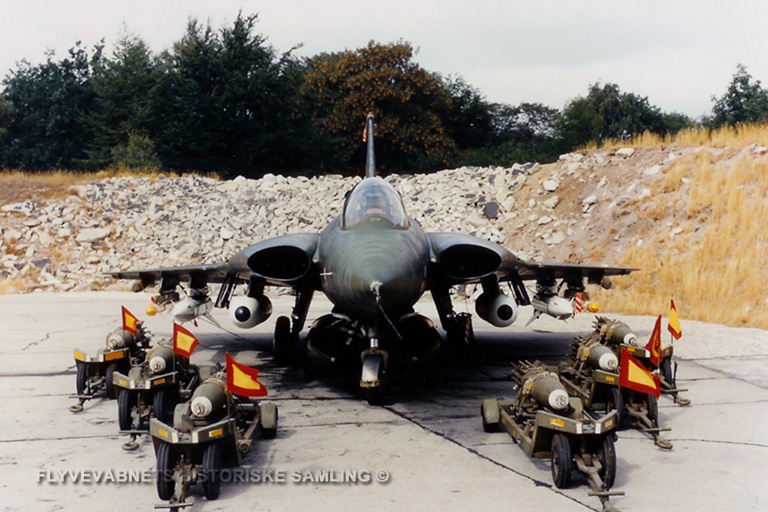It is about time I get back to this one, especially now that I just have a very good feeling about this airframe. Especially now that Denmark is officially part of the Swedish tree!
When Flyvevåbnet (Royal Danish Air Force) had to choose an aircraft to complement the F-100D in the mid-1960s, an attempt was made to find a basic type that could be adapted to both air defense, ground attack and reconnaissance. As a result, Denmark turned to Saab and requested a fighter-bomber based on the J35D. The new variant was initially named 35X, but after receiving Danish specifications, which included additional pylons on the inner and outer wing which gave it 9 pylons in total, Saab named the aircraft A35XD (Attackflygplan 35 Eksport Danmark) but Flyvevåbnet decided to use the designation F-35 . The reconnaissance (S35XD) and the two-seater variant (Sk35XD) were designated RF-35 and TF-35 respectively. Denmark wanted to reduce the number of different aircraft types because it would make both supply and maintenance easier and cheaper. Initially, it was about acquiring a squadron of fighter-bombers to supplement the F-100Ds and a squadron of reconnaissance aircraft to replace the RF-84F. The choice was between the F-5 Freedom Fighter, Mirage III and 35XD, and after a longer selection procedure, the 35XD won. The first 3 aircraft arrived in Denmark in September 1970, and the last aircraft was delivered in May 1972. However, 5 extra TF-35s were ordered in 1975, which made a total of 51 aircraft. They entered service with the squadrons ESK 725 and ESK 729.

Manufacturer: Saab
Application: Fighter-bomber
Length: 15.34m
Height: 9.42m
Wingspan: 3.89m
Empty weight: 8,000 kg
Full weight: 16,100 kg
Engine: Volvo Flygmotor RM6C
Engine thrust: 5,807/8,013 kg
Max speed: 1900 km/h/Mach 1.8
Max allowed speed, per flight manual: 1350km/h
Cruise speed: 950 km/h
Max altitude: 18,300 m
Crew: 1
The F-35 was picked based on the performance of the contemporary J35D, however the specifications required by Denmark necessitated a significant reinforcement of the airframe, wings and landing gear, as well as additional fuel tanks to fulfill its role as a fighter-bomber. That meant the maximum starting weight was 35% over that of the J35D. This caused a reduction in flight performance to a top speed of Mach 1.8 compared to the previous Mach 2.0 performance of the 35D. The flight manual of the F-35 placed a limit to not exceed the speed of 730 KIAS, equal to 1350km/h. It could exceed these speeds, but never operated above them. So what do you get in exchange for this heavier frame?
In exchange for the increased weight, you are given access to 9 pylons on the airframe. Each variant of this airframe have different configurations and availabilities, so exclusive armaments are marked accordingly.
Upon arrival to the country, the family was given access to a variety of bombs, missiles and rockets.


This list includes;
- 2 ADEN 30mm machine cannons (F/RF, TF 1 ADEN 30mm)
- 2 AGM-12B Bullpup (F/TF)
- 9 M117 750lbs bombs
- 9/14 MK82 500lbs bombs/MK82LD Snakeeye bombs
- 9 MK83 1000lbs bombs
- 9 BLU-1 napalm bombs
- 8 LAU-3/A rocket pods with 19 FFAR rockets each
–Exclusively on the outer most pylons (2R/L) - 2 AIM-9B FGW Mod.2
Standard operation consisted of the six wing pylons carrying ordnance, and two of the fuselage pylons carrying fuel. The aircraft was supplied with 9 pylons spread across the wing and body.
While the family lacks a radar or IRST, it compensates with a heavy arsenal for CAS. This is not all this series brings to the table, however. During late 1970s, the Modular Flare and Chaff Dispenser (MFCD) system was installed, which allowed for two back-to-back cassettes of 11 flares or chaff to be installed on both sides of the tailhook, giving the aircraft the option of 44 countermeasures. The airframe was also given an additional six flares on each side of the exhaust, adding an additional 12 (same modification as seen on the J35XS). These 12 were always flares. In total, the airframe could carry 56 countermeasures by the late 1970s. The aircraft also received AN/ALR-45 Radar Warning Receiver.
The addition of the MFCD also introduced the option for the TF-35 to install a pair of A38DK chaff pods on pylon 1R/L, but this was exclusive to the trainer models of the aircraft. Likewise was the option to mount AN/ALQ-71 on pylons exclusive to the two-seater version.
http://www.esk729.dk/esk729.dk/Forside.html
http://www.draken.dk/Flyvevaabnet/FlyvevaabnetsFly/Draken.html
https://www.airvectors.net/avj35.html
http://www.stall.dk/flyvevaabnets-historie-fra-1945/fly-gennem-tiden/draken.aspx
–Books/Manuals
Flight Manual F/RF/TF-35 Vol. 1/Vol. II SAAB 35XD
Saab F-35 DRAKEN T.O.1F/RF/TF-35-1½
Lockheed F-104 STARFIGHTER T.O.1F/CF-104/D-1½ (additional ordnance details)
- Yes
- No
If you liked this aircraft and what it brings, I made another suggestion for the upgraded model, F-35 WDNS, bringing more ordnance and systems to play with.



